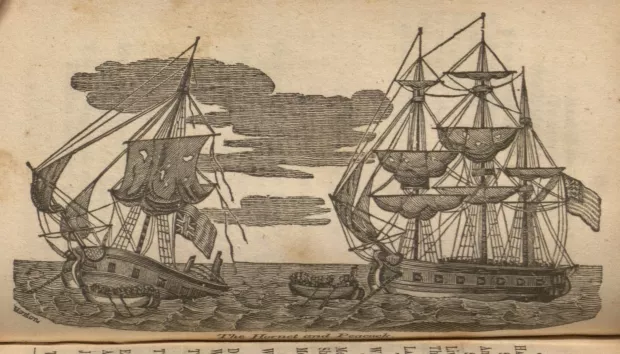Creation Date
18316
Height
6 cm
Width
10 cm
Medium
Genre
Description
This engraving portrays a battle during the War of 1812. This battle, like others in which Americans defeat the British at sea, was taken up as a subject by various American artists. One other example is Michele Felice Cornè's USS “Hornet” Sinking HMS “Peacock,” 1813. The ships in this image cross over the low horizon line. Hamilton argues that this makes them the "organizing element" of the two realms of sea and sky (R. Stein, Seascape 31, 33). The image depicts a confrontation between an American and a British ship, each displaying their national flag. The flag of the British ship, on the left, is upside down. Both ships have tattered sails. The back of the British ship is sinking into the water, and two of its masts have been reduced to jagged stumps. In contrast, the American ship sits level on the water and retains its three masts; the only evident damage is some holes in its sails. The British are abandoning their ship in two row boats and are pulling towards the American ship.
The setting of this image ties it closely to Romantic aesthetics. The sinking British ship further emphasizes the immensity of sea and sky initially created by the low horizon. In contrast, the American vessel acts as the ordering element of the vast space surrounding it; its clear, level posture renders it compatible and even equal with the sublime immensity into which the British ship descends. The American ship has achieved this equality and independence by causing the British ship's surrender to the elemental sea: it has not only managed to safely coexist with the elements, but has, temporarily, harnessed their potentially sublime power. However, the visual indication that the American ship has received some damage—the holes in its sails—separates the vulnerability of human courage and success from the omnipotence of the elements. The damage implies that the ship has indeed gone through an intense battle, and that victory, far from being effortless, required skill and bravery. This is a consistent theme throughout the Songster: it is made clear that the Americans have to work hard for their victories, and that they take pride in the dedication and stamina of their work ethic. Consequently, the events related in the Songster often dwell on difficult battles courageously fought rather than on any sort of majestic, effortless superiority. The vulnerability of the Americans' success renders their victory uniquely human, and serves to privilege the effort and uncertainty of human triumph over the sublime, inevitable power of the impersonal elements.
Associated Works
Locations Description
The introduction to The American Naval Songster (1831) was written by "Jolly Tom" in Marine Hospital, a hospital for disabled seamen near Norfolk, VA.
Copyright
Copyright 2009, Department of Special Collections, Memorial Library, University of Wisconsin-Madison, Madison, WI
Collection
Accession Number
PS595 H5 A4
Additional Information
Bibliography
By courtesy of the Department of Special Collections, Memorial Library, University of Wisconsin-Madison:
Stein, Roger B. Seascape and the American Imagination. New York: Potter, 1975. Print.
The American Naval and Patriotic Songster. Baltimore, 1831. Print.

